by José Ignacio Cabezón and THL.
The Tantric College (Ngakpa Dratsangsngags pa grwa tshang)
The Tantric College (Ngakpa Dratsangsngags pa grwa tshang) of SeraSe ra is an institution devoted exclusively to the practice of tantric ritual/meditation. There is some evidence that monks studied philosophy in some of the other tantric colleges of the GelukDge lugs tradition, but this appears never to have been the case at SeraSe ra. Instead, the Sera Tantric College (Sera Ngakpa Dratsangse ra sngags pa grwa tshang) seems to have been conceived of as a strictly ritual college from the start.
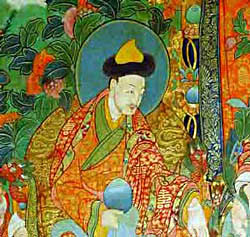 The Mongolian ruler of Tibet Lhazang KhangLha bzang khang (d. 1717), on whose behalf the Tantric College was founded | 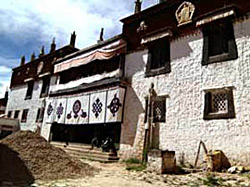 The façade of the Sera Tantric College. Sera-Tibet |
The Tantric College is the youngest of SeraSe ra’s three colleges. It was founded in the early eighteenth century as the personal ritual college of the then ruler of Tibet, Lhazang KhangLha bzang khang. The present assembly hall of the Tantric College was the original assembly hall for all of SeraSe ra.20 By the early eighteenth century, however (and probably much earlier) that temple was already too small to house all of the monks of SeraSe ra when they met jointly. When Lhazang KhangLha bzang khang came to power, he promised to build a new assembly hall (the present Great Assembly Hall), if the old assembly hall was converted into a private Tantric Ritual College (Kurim Dratsangsku rim grwa tshang): an institution that would devote itself exclusively to the performance of rituals on his behalf. The monks agreed, and the old assembly hall was converted into a ritual college. Later, this became the Tantric College, but the fact that the college still performs rituals related to, for example, the Nine Long-life Gods (Tsepak Lhagutshe dpag lha dgu), may be a vestige from the time that the college performed rituals on behalf of Lhazang KhangLha bzang khang.
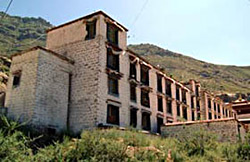
The apartment house of the Tantric College (Sera-Tibet), located just behind (north) of the Tantric College assembly hall. Before 1959 this probably belonged to the Metsang Regional House.
Before 1959 the Tantric College had no regional houses or apartment buildings. Its monks lived in the regional houses of the philosophical colleges (principally in the houses of Mé College [Dratsang Mégrwa tshang smad]), where they borrowed or rented rooms. Today, the Tantric College owns one large apartment house, formerly owned by the Metsang Regional House (Metsang Khangtsensmad tshang khang tshan), which in 2003 had been recently renovated. It is unclear why the Tantric College never built a dormitory for its monks before 1959. Perhaps there was no space for such a building already by the eighteenth century, when the Tantric College was founded. More likely, there was perhaps no need for such a regional house during that time, since the monks that populated the new Tantric College may simply have been drawn from the existing monastic populations of the JéByes and MéSmad Colleges (where they presumably already had rooms, and already belonged to regional houses). Politics may have also played a part in this, however. Since the regional houses had considerable political power within the monastery, it is not inconceivable that the two philosophical colleges might have blocked the creation of Tantric College regional houses, since agreeing to the creation of such units would have undoubtedly committed them to sharing power.
In contrast to SeraSe ra’s two other colleges – JéByes and MéSmad – the Tantric College is an institution almost entirely concerned with the practice of ritual. Before 1959, the Tantric College had a fixed, yearly liturgical cycle focusing on five major sets of deities. Click on the deity’s name to see an image of the deity on www.himalayanart.org
- Guhyasamāja (cycle celebrated in the twelfth Tibetan month)
- Cakrasaṃvara (tenth Tibetan month)
- Yamāntaka (sixth Tibetan month)
- Sarvavid (Vairocana, fourth Tibetan month)
- The Nine Long-Life Gods (Tsepak Lhagutshe dpag lha dgu, second Tibetan month)
In a typical ritual cycle (chötokchos thog) – which may run several weeks – the monks gather in the Tantric College assembly hall, they perform the self-initiation ritual (danjukbdag ’jug) and construct from colored sands the maṇḍala of the deity of that particular cycle. They then spend the bulk of the ritual cycle performing the self-generation ritual (dakyébdag bskyed) of the deity four times a day until they have accumulated the requisite number of mantra repetitions. At the conclusion of the cycle, they perform a burnt-offering ritual (jinseksbyin sreg) to purify any faults or omissions committed during the retreat cycle.
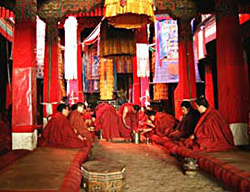 Monks of the Tantric College break for lunch during one of their ritual cycles. Sera-Tibet. | 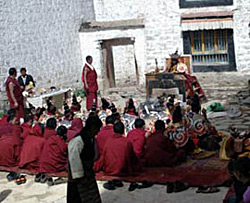 Monks of the Tantric College (Sera-Tibet) perform the burnt-offering ritual in the assembly-hall courtyard at the end of the Yamāntaka ritual cycle in July of 2002. |
Before 1959 the Tantric College had about a thousand monks, and the vast majority of these monks came from Central Tibet (mostly from LhasaLha sa).21 Like all of SeraSe ra’s institutions, the Tantric College in Tibet effectively ceased to exist from 1959 until the monastery was allowed to reopen in the early 1980s. Today, it has a monastic population of about one hundred monks. Click here to gain access to pictures of the Tantric College, including many images of the Yamāntaka burnt-offering ritual. In that window click the word sngags pa, next to “College Affiliation,” to gain access to a data window that contains demographic and other information about the Tantric College.
The JéByes and MéSmad Colleges share an abbot and have lost many of their individual traditions since their consolidation in the 1990s. The Tantric College, by contrast, retains the tradition of having its own abbot, and it continues to perform all of its ritual cycles in its own assembly hall. Like all of SeraSe ra’s colleges, however, it is under the general administrative aegis of the SeraSe ra-wide “democratic governing board.”
In India, the Tantric College was not refounded until the late 1990s. It is not part of the SeraSe ra complex in the Bylakuppe settlement, but instead exists as a separate institution in another nearby settlement.
Table of Contents
- Types of Colleges and Their Mission
- The Rise and Evolution of Sera’s (se ra) Colleges
- Glossary
- Notes
- Specify View:
- Specify Format:
 |  |  |